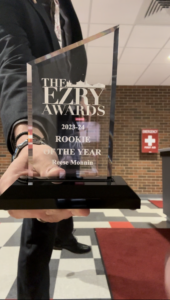Directed by Gregory Geffrard, “The Colored Museum” was a stunning theatrical performance depicting 11 different stories criticizing and celebrating black stereotypes in America. With a small cast of only seven student actors and actresses, each actor played more than one character who often spoke in long monologues, demonstrating the students’ acting skills and ability to lure in the audience as well as demand their full attention.
Opening up with lines from Martin Luther King Jr.’s famous, “I have a dream” speech, the actors posed as statues on podiums, as if in a museum. Each character represented a different time in history and struggle that the African-American community has faced and continues to face. As flight attendant for Celebrity Airlines, Miss Pat, played by Deryn Tye, ‘20, instructed passengers to “fasten their shackles” and “not rebel” while the plane soared through time and through black history.
Following Miss Pat’s plane ride through a history of oppression, Aunt Ethel, played by Taylor Benford, ‘22, hosted her daily cooking show, showing viewers how to make colored cuisine. After some blood, sweat and tears, Aunt Ethel pulled a chain of black dolls from her cooking pot, congratulating her viewers on the creation of their “batch of negros.”
Each of these short scenes forced the audience to think critically and pay close attention to every detail. One scene in particular struck an interesting cord to say the least. As the center stage feature rotated to reveal an old, worn living room, Benford, playing Mama, listened to her son, Noah Perry, ‘20, complain about the overpowering force of ‘the man’ after a long day of work. Eventually, Perry’s character gets shot several times for speaking up too loudly against the man, and his wife, Shante Leslie, ‘22, mama and sister, Tye, simply look at him and say that if only he were born in a musical, then he would still be alive.
After the women sing a piece about dancing their way through life as if in a musical, Perry’s character is reborn, changing the upbeat and comical tone into something somber and depressing. The characters kept repeating the line, “if we wanna live we gotta dance.”
Personally, I took that scene as a representation of the white man’s control over African Americans and played with the “dance boy dance” imagery. But, audience members Taylor Wallrauch, ‘19, and Lily Amurgis, ‘19, took it upon themselves to look up the underlying meanings of each scene after the play to compare to what they initially thought it to be.
“Things like this can have so many different meanings,” Wallrauch said. “The scene with the rotating middle was actually referencing the book ‘A Raisin in the Sun’ which I actually read a long time ago.”
Both students were amazed by the student production and thought that all the students did a fantastic job with such a hard piece.
“I was especially blown away with Daniel [Lofton],” Wallaruch said. “I think he’s so comfortable with himself and I admire that because I could never do something like that.”
While not every scene was as easy to understand as some of the others, both students agreed that, as their first show to see at Witt, the performance was incredible.
“Each scene had all these different stories and I was waiting for them all to connect with one plot line,” Amurgis said. “But then at the end, I realized that the underlying plot line was racism and oppression in America.”






